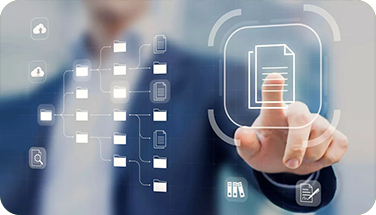The Digital Transformation of Procurement
Digital transformation is reshaping all industries, and in recent years, the procurement area has been undergoing a heavy shift toward digitalization.
Traditionally, procurement involved many manual processes that relied heavily on paperwork, leading to limited visibility for professionals. However, with new digital technologies, procurement has entered a new era of optimization, efficiency, transparency, and innovation.

The Evolution of Procurement
Procurement has come a long way from its humble beginnings as a paper-based, administrative business function. In the past, procurement professionals relied heavily on physical documentation, spreadsheets, and manual communication to manage the sourcing and purchasing processes.
This approach was time-consuming and prone to errors and inefficiencies. Thanks to the rise of digital technologies, procurement has experienced a true revolution.
The widespread adoption of Cloud-based solutions, big data analysis, artificial intelligence, and process automation technologies has propelled procurement into a new era of digital transformation.
What are the Key Components of Digital Transformation in Procurement?
Let’s look at the innovations reshaping how procurement professionals operate.
Cloud-based Procurement Platforms
Cloud-based Procurement Platforms like Unit4 Source-to-contract by Scanmarket have revolutionized procurement by offering scalable, flexible, and accessible solutions.
Procurement platforms hosted in the Cloud provide organizations with a centralized and collaborative ecosystem that empowers professionals to manage sourcing, supplier relationships, related contracts, and all purchasing activities.
These platforms eliminate the need for on-premises infrastructures, allowing procurement professionals to work from any location, at any time, and on any device. Cloud-based solutions also allow easy integration with other systems, enabling efficient data consolidation and cleaning.
Big Data Analytics
The availability of vast amounts of data has completely transformed procurement into a data-driven function. Advanced analytics tools and machine learning algorithms enable organizations to mine data for valuable insights from procurement activities.
By analyzing historical and real-time data, businesses can optimize their spend management, identify savings opportunities, and mitigate supply chain risks.
Data-driven decision-making enhances procurement strategies, fosters supplier relationships, and drives overall business performance.
AI and Process Automation Technologies
Artificial intelligence and Process Automation technologies automate repetitive and manual tasks in procurement, enabling professionals to focus on more strategic activities.
AI-powered solutions improve supplier communication by providing real-time information, setting alerts for supplier-related activities requiring human attention, and automating purchasing orders.
On the other hand, Process Automation technologies streamline invoice processing, contract management processes, and any related data entries, significantly reducing errors and cycle times.
Combining both technologies enhances efficiency, accuracy, and collaboration within the procurement function.
Click to read Analyst & Influencers (For External Use) Gated
eRFx and eAuction Software
eRFx is a term that encompasses a range of electronic Request For "x" processes, where "x" can stand for Information (RFI), Quotation (RFQ), Proposal (RFP), or other similar documents.
eRFx allows procurement professionals to obtain information from suppliers easily and, together with eAuction software, transfer the most competitive suppliers to virtual auctions.
In these virtual auctions, suppliers bid competitively to win contracts for providing goods or services. This software facilitates various types of auctions, such as reverse auctions, where suppliers compete to offer the lowest price, or forward auctions, where buyers compete to purchase a product or service.
This allows businesses to optimize their sourcing events, ensure they receive the best possible pricing, and improve the overall efficiency of their procurement processes.
What are the Benefits of the Digital Transformation of Procurement?
Technological advancements in procurement are revolutionizing procurement practices and driving business success:
Enhanced Efficiency and Productivity
Digital procurement streamlines processes, eliminates manual errors, and automates routine tasks, resulting in overall improved efficiency and productivity.
Electronic sourcing reduces cycle times, enhances stakeholder collaboration, and eliminates bottlenecks due to inefficient paperwork.
Automation frees procurement professionals to focus on more strategic initiatives, supplier relationship management, and innovation.
Cost Savings and Spend Optimization
The digital transformation of procurement also enables organizations to optimize spend management and quickly identify cost-saving opportunities.
Through advanced analytics, businesses can analyze all historical spend data, benchmark supplier prices, negotiate better contracts, and identify any potential savings.
Automating invoice processing and payment systems reduces errors, helps eliminate late payment penalties, and ensures adherence to previously negotiated terms, contributing to cost savings.
Improved Visibility and Transparency
Digital procurement provides real-time visibility into procurement activities and supplier performance. Centralized procurement platforms and spend analytics solutions enable organizations to track orders, monitor supplier compliance, and mitigate any associated risks.
Improved visibility enhances decision-making, drives accountability, and fosters trust and collaboration with suppliers.
Rapid Adaptation to Sudden Market Changes
The digitalization of procurement also enables organizations to quickly adapt to sudden market changes. Businesses that rely on Cloud-based and automation technologies can rapidly onboard new suppliers and easily respond to new market demands.
Enhanced Supplier Collaboration and Relationships
The digital transformation of procurement improves collaboration with suppliers by providing a centralized and transparent environment. Real-time communication through in-platform communication tools and streamlined collaboration tools enhances supplier performance management and reduces cycle times.
Conclusion
The digital transformation of procurement has revolutionized how organizations manage their relationships with suppliers, drive efficiency, and unlock data-driven business decisions.
Cloud-based solutions, data analytics, artificial intelligence, and process automation tools have transformed procurement from a manual, prone-to-error process to an agile, data-driven function.
Organizations embracing digital procurement gain a competitive business advantage, can adapt quickly to sudden market changes, and position themselves for long-term success.
To fully harness the potential of digital transformation, organizations should invest in robust procurement technologies to promote a culture of efficiency, transparency, and collaboration.
How Unit4 by Scanmarket can optimize your procurement processes
Unit4 Source-to-contract by Scanmarket procurement software offers a comprehensive, Cloud-based solution that enhances efficiency, transparency, and control over procurement processes.
With its advanced analytics, seamless integration capabilities, and robust automation features, Unit4 streamlines sourcing, supplier management, and contract management.
Our software empowers procurement professionals to make data-driven decisions, optimize spend, and foster stronger supplier relationships, ultimately driving cost savings and improving overall business performance.
Its user-friendly interface and scalable design make it ideal for organizations looking to modernize their procurement operations and stay competitive in today's dynamic market.
You can check out our full suite of procurement solutions here.





